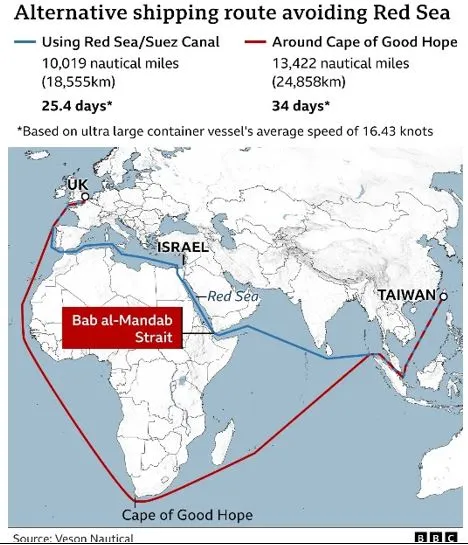

5th July 2024 (9 Topics)
Context
Recent months have brought significant challenges to the global shipping industry. While there is no respite in the Middle East for the shipping industry that continues to face hardship due to the Red Sea route suspension, there is now tension in the South East due to severe congestion at Singapore port and China’s Shanghai/Ningbo ports has only aggravated the disruptions.
What is Red Sea crisis?
- The Red Sea crisis involves increased attacks by Iran-backed Houthi rebels in Yemen on commercial ships in the Bab-el-Mandeb strait, a narrow passage connecting the Arabian Peninsula and the Horn of Africa.
- These attacks have intensified since late November and are seen as a response to Israel's actions in Gaza.
- The Bab-el-Mandeb strait is crucial because it serves as a gateway for ships traveling from Asia to the Suez Canal, which handles about 12% of global trade. This route is vital for transporting goods like oil from the Persian Gulf to Europe and North America.
- Due to the attacks, ships may need to take a longer route around the Cape of Good Hope in southern Africa, adding about 10 days and 6,000 kilometers to their journey between Europe and Asia.
Impact of Red Sea Attacks on Shipping
- The shipping industry, responsible for approximately 80% of global trade, continues to grapple with the repercussions of frequent attacks on vessels navigating the Red Sea.
- This sustained threat has forced the suspension of routes critical for maritime trade, exacerbating logistical bottlenecks and delays.
- Congestion Crisis in Southeast Asia: The ports of Singapore, Shanghai, and Ningbo—key hubs connecting Asia to Europe and beyond—are experiencing unprecedented congestion.
- Delay: The bunching of vessels outside these ports has disrupted ship rotations and significantly delayed cargo handling processes. Indian exporters, reliant on Singapore and Port Klang for transshipment, are particularly affected.
- Increasing cost: This delay has compelled many vessels to bypass Singapore altogether, complicating logistics planning and increasing costs for exporters, as evidenced by rising container prices from $950 to over $1,200 since September 2023.
- Affected movements: The congestion crisis in Singapore and neighboring ports like Port Klang is disrupting global trade flows, affecting the movement of goods between Asia, Europe, and the Americas.
How a new route can change things for India?
- A multimodal route that includes a railway, roadway network and seaports, the INSTC spans 7,200km (4,500 miles) from St. Petersburg to the port of Mumbai in India.
- INSTC connects Russia to India through Iran's Chabahar port.
- INSTC is being seen as an alternative to the Suez Canal trade route.
The INSTC corridor can be a critical geostrategic tool India needs to enhance its trade footprints in Central Asia.
Maritime Routes:
|



